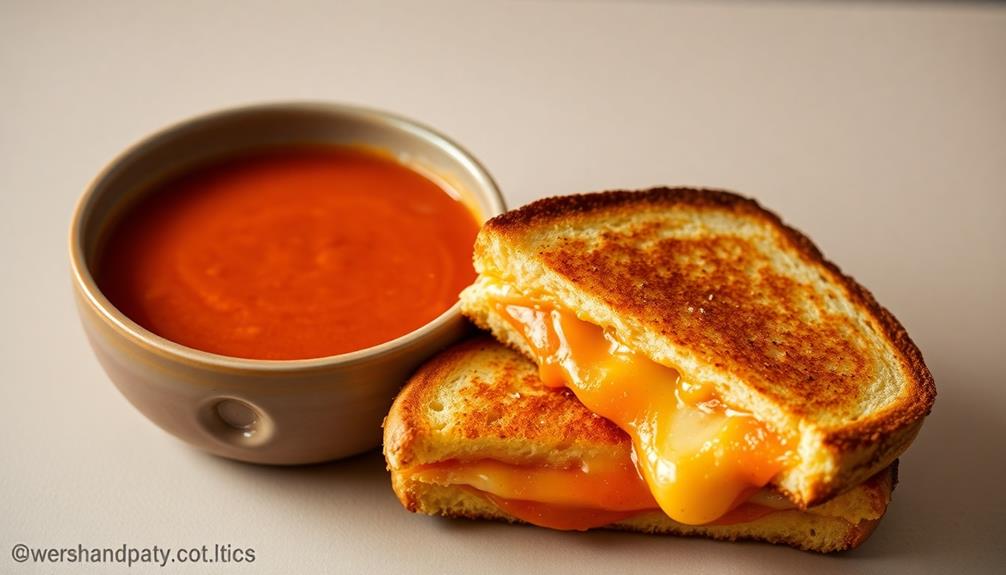You're in for a real treat with this classic combo of tomato soup and grilled cheese! Tomato soup and grilled cheese have been a beloved pairing since the early 1900s, becoming especially popular during the Great Depression when the hearty, comforting meal was both affordable and satisfying. Over the years, the classic dish has evolved with the addition of herbs, spices, and different cheeses, but the simple pleasure of dipping a perfectly golden grilled cheese into a rich, creamy tomato soup remains a timeless delight. Let's dive into the easy steps to make this nostalgic favorite at home!
Key Takeaways
- Tomato soup and grilled cheese is a classic, comforting pairing with roots in the early 20th century, gaining popularity during the Great Depression.
- The simple pleasure of dipping a crispy grilled cheese sandwich into a creamy tomato soup remains a timeless nostalgic favorite.
- The soup is made by sautéing onions and garlic, adding diced tomatoes and broth, and simmering to achieve the desired consistency.
- Optional additions like cream or milk can enhance the texture and flavor of the tomato soup.
- The blended, velvety-smooth soup pairs perfectly with the crunch and melty cheese of the grilled cheese sandwich for a comforting, harmonious meal.
History
Tomato soup and grilled cheese sandwiches have long been a beloved pairing, with roots dating back to the early 20th century.
It's believed the combination gained popularity during the Great Depression, when families looked for affordable, comforting meals. The creamy tomato soup and crispy, cheesy bread became a quick, satisfying lunch or dinner option.
Over the years, this classic duo has evolved, with home cooks and chefs putting their own spin on the classic. Some add herbs, spices, or even bacon to the soup, while others experiment with different types of cheese or bread for the sandwich.
No matter the variations, the simple pleasure of dipping a warm, gooey grilled cheese into a steaming bowl of tomato soup has endured.
Today, this beloved pairing remains a nostalgic favorite, evoking memories of childhood and simpler times.
Whether enjoyed at home or in a cozy cafe, the combination of tomato soup and grilled cheese continues to bring comfort and joy to generations of food lovers.
Cooking Steps
First, gather your ingredients and prep them for cooking. You'll need to dice up an onion and mince some garlic.
Then, grab a can of diced tomatoes and a carton of chicken or vegetable broth. For the grilled cheese, you'll want some slices of bread and your favorite type of cheese, like cheddar or Swiss.
Next, in a large pot, sauté the onion and garlic in a bit of olive oil until they're soft and fragrant.
Pour in the can of tomatoes and the broth, then let the soup simmer for about 15 minutes.
Grab your grilled cheese ingredients and start assembling the sandwiches. Butter the outside of the bread slices, then layer the cheese in between.
Cook the sandwiches in a skillet or on a griddle until the bread is golden brown and the cheese is melted.
Step 1. Heat Oil in Saucepan
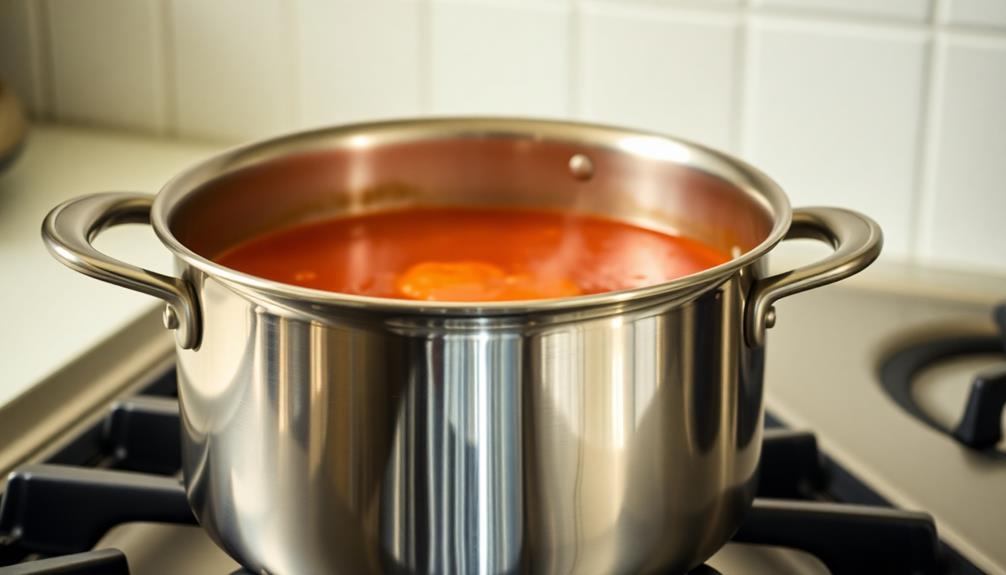
Go ahead and heat up a saucepan over medium heat. You want the pan to get nice and toasty before adding the oil.
Once it's hot, pour in a couple of tablespoons of olive oil. Swirl the pan to coat the bottom evenly. The oil should start to shimmer, letting you know it's ready for the next step.
Now, you can add your chopped onions to the hot oil. Give them a stir and let them sizzle for a minute or two, until they become soft and translucent.
Be sure to keep an eye on them, as you don't want the onions to burn. The aroma of the onions cooking in the oil will start to fill your kitchen, making your mouth water in anticipation.
After the onions have softened, it's time to add the garlic. Mince or press a couple of cloves and toss them into the pan.
Stir everything together and let the garlic cook for about a minute, until it becomes fragrant. This will infuse your soup with amazing flavor.
Step 2. Add Tomato Paste and Broth
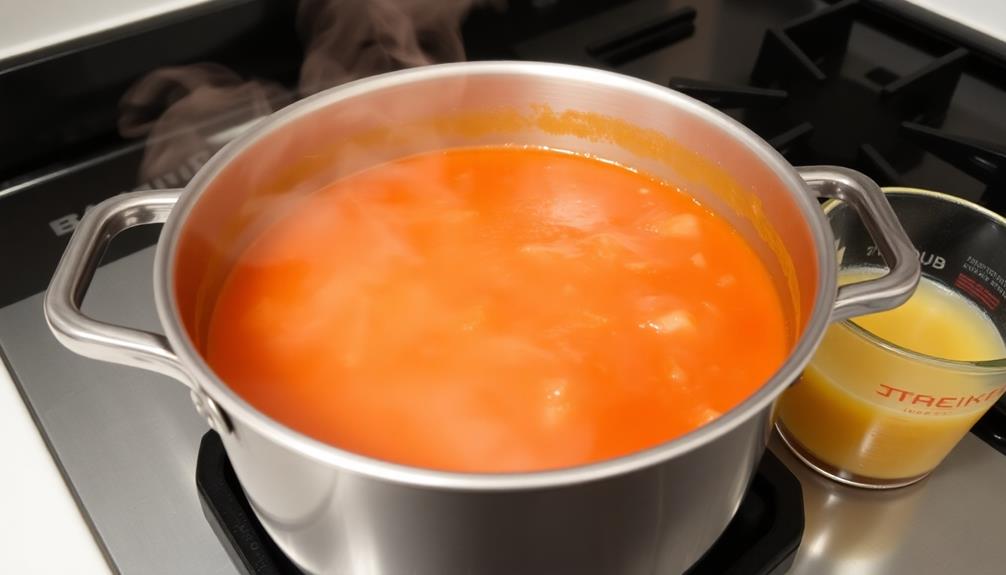
With the aromatic onions and garlic ready, it's time to add the tomato paste and broth. Scoop in a couple tablespoons of tomato paste and stir it into the sautéed vegetables. The paste will instantly deepen the color and infuse the mixture with a rich, tomatoey flavor. For an extra layer of taste, consider using high-quality tomato paste, which can enhance your dish significantly.
Additionally, you can complement your meal with some natural remedies alongside conventional medications to aid digestion.
Next, pour in the chicken or vegetable broth. You'll want about 4 cups of broth to create a nicely balanced soup. Stir everything together and let it simmer for 10-15 minutes. This allows the flavors to meld and the soup to thicken slightly. Finally, add in the cooked chicken and your choice of noodles, such as egg noodles or spaghetti broken into smaller pieces. Let the soup simmer for an additional 10-15 minutes, or until the noodles are cooked through. Your classic chicken noodle soup recipe is now ready to be served and enjoyed by the whole family. This comforting and delicious soup is perfect for any time of the year.
Keep an eye on it, giving it a stir every now and then. The aroma filling your kitchen will have your taste buds tingling in anticipation!
Once the time is up, your tomato soup base is ready. Taste and adjust the seasoning as needed, adding a pinch more salt and pepper if desired.
Now you can move on to the next step – blending the soup to achieve that signature velvety texture.
Step 3. Simmer Until Desired Consistency
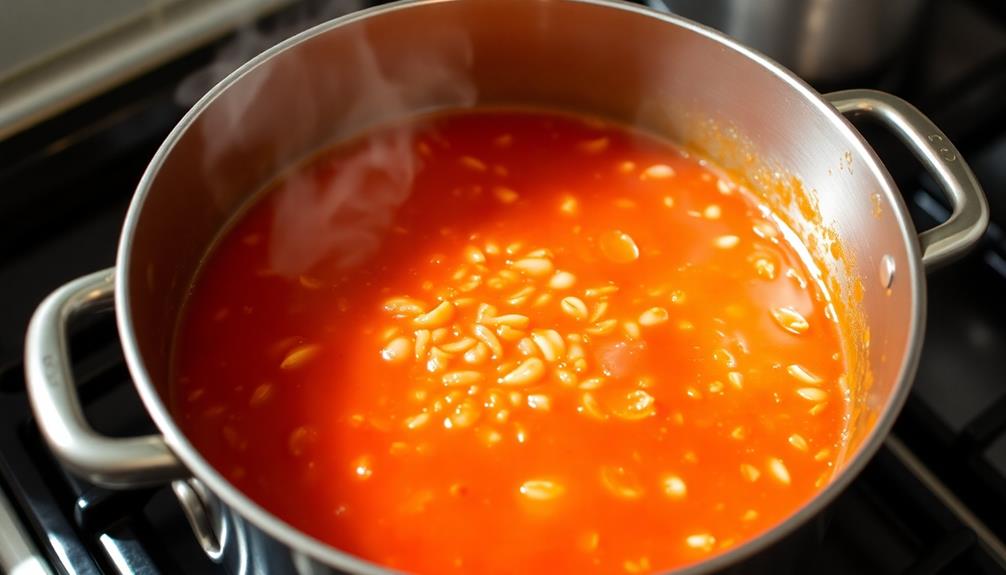
Reduce the heat to low and let the soup simmer for 10-15 minutes, stirring occasionally. This step is key to getting the perfect texture for your tomato soup.
As it simmers, the flavors will blend together and the soup will thicken up to your desired consistency. You'll want to keep an eye on it, giving it a stir now and then to prevent any sticking or burning.
The smell of the simmering soup will fill your kitchen, making your mouth water in anticipation. Once the soup has reached your preferred thickness, it's ready to serve.
Grab your grilled cheese sandwich and dip it right into the hot, flavorful soup. The creamy texture and tangy tomato taste will be a comforting and delicious pairing.
Don't be afraid to adjust the simmering time to get the consistency you love – it's all about finding that perfect balance.
Step 4. Add Cream or Milk
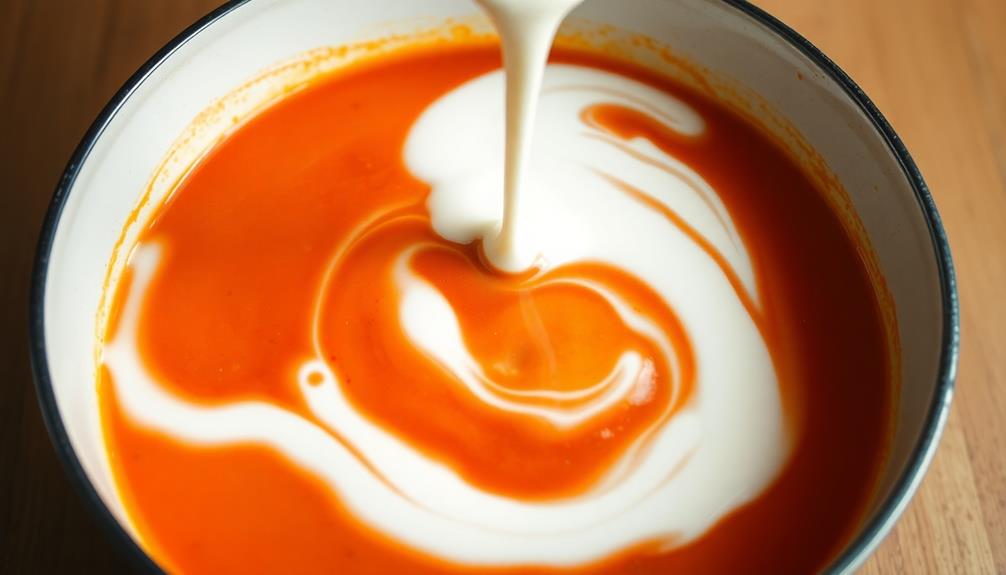
Once the soup has simmered to your desired consistency, you can opt to add a splash of cream or milk to make it even more luxuriously creamy.
This step is entirely optional, but it can really take your tomato soup to the next level. The cream or milk will mellow out the acidity of the tomatoes, creating a silky-smooth texture that's simply divine.
Additionally, incorporating rich, creamy flavor into your soup enhances the overall taste experience. Just be sure to stir it in gently, so you don't disrupt the delicate balance of flavors.
Start with a small amount, like a quarter cup, and taste as you go. You can always add more if you want an even creamier soup. The key is to find the perfect balance that suits your personal preferences.
Whether you choose to use cream or milk, this simple addition will leave you with a comforting, velvety-smooth tomato soup that's sure to satisfy.
Step 5. Blend Soup With Immersion Blender
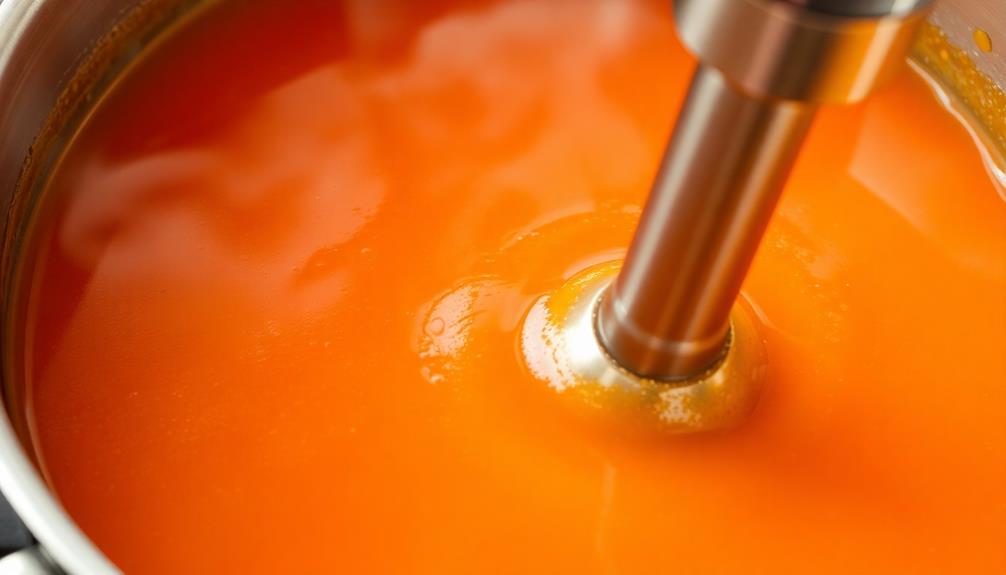
Next, use an immersion blender to carefully blend the soup until it reaches your desired consistency. This handy tool will transform the chunky tomatoes into a silky, smooth texture.
Gently insert the immersion blender into the pot and begin pulsing it up and down. Move it around the pot to ensure you blend all the ingredients thoroughly. Keep a close eye on the soup, blending in short bursts to avoid splatters.
You want a creamy, velvety soup, but be careful not to over-blend, as that can make the texture too thin. Once you've reached your preferred consistency, give the soup a quick taste and add any additional salt and pepper if needed.
The immersion blender makes this step a breeze, allowing you to easily customize the texture to your liking. With just a few minutes of blending, you'll have a wonderfully smooth and comforting tomato soup, perfect for dipping your grilled cheese sandwich.
Final Thoughts
Tomato soup and grilled cheese is a classic combination that never fails to satisfy. It's a comforting and nostalgic dish that brings back memories of cozy afternoons or chilly evenings. The creamy tomato soup pairs perfectly with the crispy, gooey grilled cheese, creating a harmonious blend of flavors and textures.
As you sit down to enjoy this delightful meal, you can't help but feel a sense of warmth and contentment. The aroma of the soup and the crunch of the bread will tantalize your senses, making your mouth water in anticipation. Each spoonful of the smooth, velvety soup and each bite of the melted cheese sandwich will leave you feeling satisfied and happy.
Tomato soup and grilled cheese is a timeless classic that will always have a special place in your heart and on your table. It's a comforting and comforting meal that can be enjoyed any time, any day, and in any season.
Frequently Asked Questions
Can I Use a Different Type of Cheese for the Grilled Cheese?
Absolutely! You can use any type of cheese you'd like for your grilled cheese.
From classic cheddar to tangy Swiss, the possibilities are endless. The key is to choose a cheese that melts nicely and complements the flavors you enjoy.
Feel free to get creative and experiment with different cheese combinations – the options are limitless!
Just be sure to toast your bread to perfection for the ultimate grilled cheese experience.
How Can I Make the Tomato Soup Creamier?
To make your tomato soup creamier, try adding a splash of heavy cream or whole milk. This will give it a rich, velvety texture that's simply divine.
You can also blend in a few tablespoons of butter or cream cheese for an extra creamy kick.
Don't be afraid to experiment – play around with the amounts until you find the perfect consistency that tickles your taste buds.
Get ready for a soup so creamy, you'll want to curl up with a big bowl of it!
Is It Possible to Make This Recipe Vegan?
Absolutely! You can easily make this tasty tomato soup vegan.
Just swap out the dairy ingredients for plant-based alternatives. Use unsweetened almond or oat milk instead of regular milk, and opt for a vegan cheese or skip the grilled cheese altogether.
The soup itself is already vegan-friendly, so you're halfway there.
With a few simple swaps, you can enjoy a delicious, creamy tomato soup that's perfect for any diet!
Can I Use Canned Tomatoes Instead of Fresh?
Absolutely! Canned tomatoes are a fantastic option for making vegan tomato soup.
They're convenient, budget-friendly, and often just as flavorful as fresh tomatoes. The best part? You can find canned tomatoes year-round, so you can enjoy this cozy, comforting soup anytime.
Just be sure to check the label and choose a brand without added salt or preservatives.
With canned tomatoes, you'll have a delicious vegan soup ready in no time!
How Long Does the Grilled Cheese Take to Cook?
Making a grilled cheese sandwich is a breeze!
It usually takes about 3-5 minutes per side to get that golden-brown crunch and perfectly melted cheese inside.
Keep an eye on it, flipping occasionally, until it reaches your desired level of toastiness.
Don't forget to use a non-stick pan or griddle to make the process even easier.
With a little practice, you'll be whipping up delicious grilled cheese sandwiches in no time!
